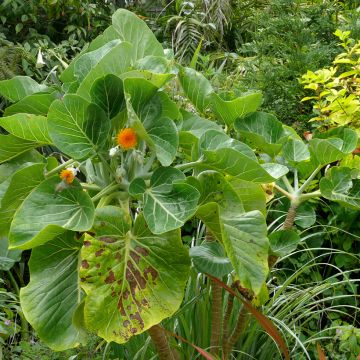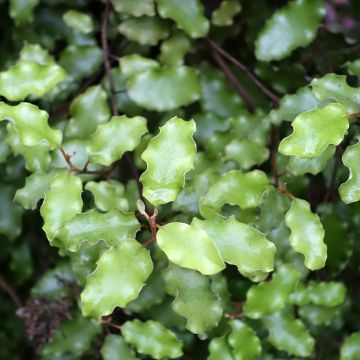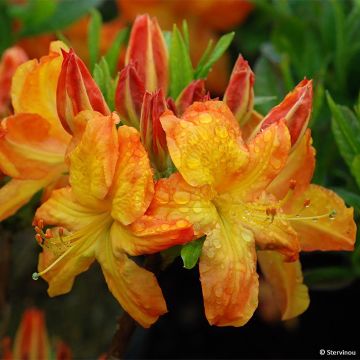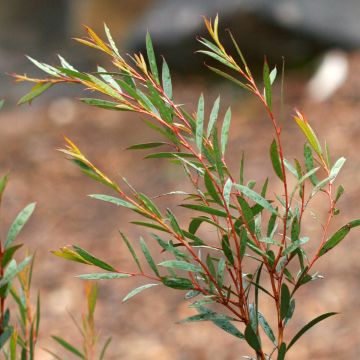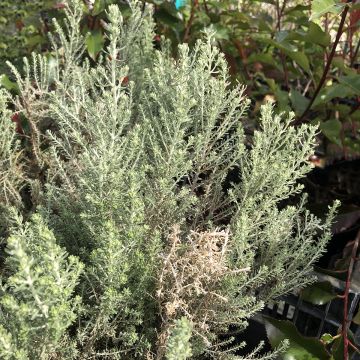

Olearia solandri Aurea
Olearia solandri Aurea
Olearia solandri Aurea
Coastal Daisybush, Solander's Daisybush
planted before the heat, dead despite waterings and mulching
Laurence, 25/10/2022
Special offer!
Receive a €20 voucher for any order over €90 (excluding delivery costs, credit notes, and plastic-free options)!
1- Add your favorite plants to your cart.
2- Once you have reached €90, confirm your order (you can even choose the delivery date!).
3- As soon as your order is shipped, you will receive an email containing your voucher code, valid for 3 months (90 days).
Your voucher is unique and can only be used once, for any order with a minimum value of €20, excluding delivery costs.
Can be combined with other current offers, non-divisible and non-refundable.
Home or relay delivery (depending on size and destination)
Schedule delivery date,
and select date in basket
This plant carries a 24 months recovery warranty
More information
We guarantee the quality of our plants for a full growing cycle, and will replace at our expense any plant that fails to recover under normal climatic and planting conditions.
Would this plant suit my garden?
Set up your Plantfit profile →
Description
The Olearia solandri Aurea distinguishes itself from other Olearia by its appearance as a large bushy heather with yellow-bronze foliage. Aerial and fluffy, it possesses the somewhat wild charm inherent to plants that thrive along the shores and allow the wind to shape their silhouette like a landscape. In late summer, its honey-scented flowering softens its foliage, suddenly sprinkled with discreet daisies barely tinged with yellow. Its low hardiness and resistance to drought reserve it, when planted in the ground, for regions spared from severe frost, in mild oceanic or Mediterranean climates. Elsewhere, it can be grown in a large pot and stored in a cold greenhouse during the winter.
The Olearia solandri, also known as the Coastal Daisy-bush in its country, is a shrub of the aster family native to the coasts of New Zealand. This evergreen shrub, with an aerial habit, sometimes a bit scruffy, overall rounded, will reach an average size of 2m (7ft) in all directions, with rapid growth. 'Aurea', from which it originates, distinguishes itself with foliage in a more golden tone. Its angular branches are golden yellow when young and darken with age, bearing tiny leaves measuring 4 to 8mm (1in) in length, very narrow, arranged in an alternate and whorled manner. They are bronze to golden green on the upper side, lighter and felted on the underside. The flowering is not spectacular but very fragrant. It takes place in August-September, in the form of numerous small solitary heads measuring 8mm (1in) in diameter that open along the branches. These inflorescences resemble tiny cream-yellow asters. The flowering is followed by the formation of a fruit called an achene; seed dispersal is ensured by the wind.
Hardy up to approximately -7/-8°C, the Olearia solandri Aurea will naturally find its place in a coastal garden, spared from severe frost, in the front line facing the sea spray. Elsewhere, it should be protected from cold and drying winds. It can be planted as a hedge, as its stature allows it to form a protective screen against the wind, and the texture of its foliage evokes that of certain conifers from a distance. It will form an elegant grove or large, harmonious flower bed, together with shrubs that flower in summer or autumn such as Grevillea, Summer Tamarisk (Tamarix ramosissima), Arbutus, and Abelia (grandiflora and chinensis). Pruning can be done to give it a denser, more compact habit and to keep it in more modest proportions. It can be planted with other small evergreen shrubs such as Leptospermum (Nanum Tui, Martinii, Silver Sheen), Atriplex halimus, Anthyllis barba-jovis, Erica multiflora, or Artemisia arborescens. It is perfectly suited to gardens along the oceanic coast where it appreciates sandy or humus-rich soils, but it tolerates Mediterranean summers quite well if well-watered, and a light, deep, flexible soil without excessive limestone content.
Report an error about the product description
Olearia solandri Aurea in pictures




Plant habit
Flowering
Foliage
Botanical data
Olearia
solandri
Aurea
Asteraceae
Coastal Daisybush, Solander's Daisybush
Oceania
Other Olearia
View all →Planting and care
We recommend planting Olearia in autumn in very mild, warm and dry climates in summer, in spring in cooler and more humid regions in summer. Olearia solandri Aurea will thrive in a light, well-drained, deep soil. It prefers to remain slightly moist in summer, especially in Mediterranean climates, even though it tolerates summer drought quite well. Loose, deep soil, whether rich in humus or poor, slightly rocky or sandy, slightly acidic, neutral or even slightly alkaline, will do. It tolerates sea spray very well. It requires a very sunny exposure to flourish. Under these conditions, once well established, it is hardy down to -7 or -8°C (19.4 or 17.6°F) and can live for many years. However, in our regions further away from the sea, it will be necessary to cultivate it in a large pot and store it indoors in a bright, but unheated room during winter. To shape it, you can trim the stems (lightly) in March-April to encourage branching.
Pot culture:
Provide good drainage in the bottom of the pot, which should be of large volume, as the plant offers a large surface area to the wind. Use a light substrate, enriched with coarse sand and leaf compost, and add a little slow-release fertilizer in late winter and autumn. Water generously in summer, allowing the soil to dry out a little between waterings.
Diseases and pests:
Mealybugs sometimes attack Olearia. Regularly inspect the stems and undersides of the leaves to detect this pest, forming shields or powdery clusters. Apply an anti-mealybug treatment. In case of severe infestation, prune severely just above the last bud located near the base of the stem.
Propagation: by stem cuttings after flowering, in summer.
Planting period
Intended location
Care
-
, onOrder confirmed
Reply from on Promesse de fleurs
Similar products
Haven't found what you were looking for?
Hardiness is the lowest winter temperature a plant can endure without suffering serious damage or even dying. However, hardiness is affected by location (a sheltered area, such as a patio), protection (winter cover) and soil type (hardiness is improved by well-drained soil).

Photo Sharing Terms & Conditions
In order to encourage gardeners to interact and share their experiences, Promesse de fleurs offers various media enabling content to be uploaded onto its Site - in particular via the ‘Photo sharing’ module.
The User agrees to refrain from:
- Posting any content that is illegal, prejudicial, insulting, racist, inciteful to hatred, revisionist, contrary to public decency, that infringes on privacy or on the privacy rights of third parties, in particular the publicity rights of persons and goods, intellectual property rights, or the right to privacy.
- Submitting content on behalf of a third party;
- Impersonate the identity of a third party and/or publish any personal information about a third party;
In general, the User undertakes to refrain from any unethical behaviour.
All Content (in particular text, comments, files, images, photos, videos, creative works, etc.), which may be subject to property or intellectual property rights, image or other private rights, shall remain the property of the User, subject to the limited rights granted by the terms of the licence granted by Promesse de fleurs as stated below. Users are at liberty to publish or not to publish such Content on the Site, notably via the ‘Photo Sharing’ facility, and accept that this Content shall be made public and freely accessible, notably on the Internet.
Users further acknowledge, undertake to have ,and guarantee that they hold all necessary rights and permissions to publish such material on the Site, in particular with regard to the legislation in force pertaining to any privacy, property, intellectual property, image, or contractual rights, or rights of any other nature. By publishing such Content on the Site, Users acknowledge accepting full liability as publishers of the Content within the meaning of the law, and grant Promesse de fleurs, free of charge, an inclusive, worldwide licence for the said Content for the entire duration of its publication, including all reproduction, representation, up/downloading, displaying, performing, transmission, and storage rights.
Users also grant permission for their name to be linked to the Content and accept that this link may not always be made available.
By engaging in posting material, Users consent to their Content becoming automatically accessible on the Internet, in particular on other sites and/or blogs and/or web pages of the Promesse de fleurs site, including in particular social pages and the Promesse de fleurs catalogue.
Users may secure the removal of entrusted content free of charge by issuing a simple request via our contact form.
The flowering period indicated on our website applies to countries and regions located in USDA zone 8 (France, the United Kingdom, Ireland, the Netherlands, etc.)
It will vary according to where you live:
- In zones 9 to 10 (Italy, Spain, Greece, etc.), flowering will occur about 2 to 4 weeks earlier.
- In zones 6 to 7 (Germany, Poland, Slovenia, and lower mountainous regions), flowering will be delayed by 2 to 3 weeks.
- In zone 5 (Central Europe, Scandinavia), blooming will be delayed by 3 to 5 weeks.
In temperate climates, pruning of spring-flowering shrubs (forsythia, spireas, etc.) should be done just after flowering.
Pruning of summer-flowering shrubs (Indian Lilac, Perovskia, etc.) can be done in winter or spring.
In cold regions as well as with frost-sensitive plants, avoid pruning too early when severe frosts may still occur.
The planting period indicated on our website applies to countries and regions located in USDA zone 8 (France, United Kingdom, Ireland, Netherlands).
It will vary according to where you live:
- In Mediterranean zones (Marseille, Madrid, Milan, etc.), autumn and winter are the best planting periods.
- In continental zones (Strasbourg, Munich, Vienna, etc.), delay planting by 2 to 3 weeks in spring and bring it forward by 2 to 4 weeks in autumn.
- In mountainous regions (the Alps, Pyrenees, Carpathians, etc.), it is best to plant in late spring (May-June) or late summer (August-September).
The harvesting period indicated on our website applies to countries and regions in USDA zone 8 (France, England, Ireland, the Netherlands).
In colder areas (Scandinavia, Poland, Austria...) fruit and vegetable harvests are likely to be delayed by 3-4 weeks.
In warmer areas (Italy, Spain, Greece, etc.), harvesting will probably take place earlier, depending on weather conditions.
The sowing periods indicated on our website apply to countries and regions within USDA Zone 8 (France, UK, Ireland, Netherlands).
In colder areas (Scandinavia, Poland, Austria...), delay any outdoor sowing by 3-4 weeks, or sow under glass.
In warmer climes (Italy, Spain, Greece, etc.), bring outdoor sowing forward by a few weeks.


































